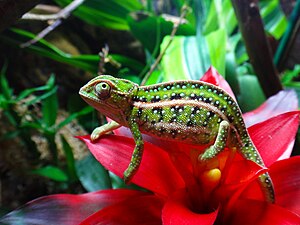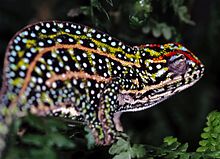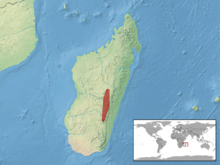Furcifer campani
| Furcifer campani | ||||||||||||
|---|---|---|---|---|---|---|---|---|---|---|---|---|

Furcifer campani , female |
||||||||||||
| Systematics | ||||||||||||
|
||||||||||||
| Scientific name | ||||||||||||
| Furcifer campani | ||||||||||||
| ( Grandidier , 1872) |

Furcifer campani is endemic to Madagascar occurring chameleon -Art. The specific epithet honorsDominique Campan, a French resident of Madagascar.
features
Furcifer campani , one of the smaller chameleon species , reaches a length of 14 centimeters. Its color varies from light green to dark green to dark brown. It shows large dark spots as well as light brown lateral stripes that run along each side of the body. The entire surface of the body is covered with numerous small, slightly raised, brightly shimmering spots. The head is usually also decorated with small red, pearl-like spots on a raised eye ridge, which give the animal a colorful pattern. In English usage, the species is therefore called Jeweled chameleon = '(with jewels) adorned chameleon'. The head has a slightly flattened helmet structure. The back does not have a scalloped comb, and there are no nose appendages. Furcifer campani has the ability to change color significantly. In particular, in order to impress the females, the males sometimes take on a deep black-brown body color, from which small white dots stand out.
distribution and habitat
The species occurs in the central highlands of Madagascar at altitudes between 1850 and 2300 meters. It is found primarily in low bushes and in grasslands between shrubs and rocks.
Way of life
Furcifer campani feeds on various insects that are ambushed by shooting out their long, sticky-tipped tongue. Sometimes they wait immobile for long periods of time until suitable prey comes within range. Two to three times a year, the females lay eight to twelve eggs, which they hide well. Under breeding conditions in captivity, the young hatched after nine months, provided the eggs were kept at a constant temperature of 20 ° C. They become sexually mature just three months after hatching. Further details on the species' way of life have yet to be explored.
Danger
Since many habitats of Furcifer campani are being destroyed due to reclamation by humans, the species is classified as ![]() ( vulnerable = endangered) by the IUCN . Because of the attractiveness of the animals in terms of color, illegal removal from nature and unlawful transfer to the pet trade also pose a certain threat to the species.
( vulnerable = endangered) by the IUCN . Because of the attractiveness of the animals in terms of color, illegal removal from nature and unlawful transfer to the pet trade also pose a certain threat to the species.
Individual evidence
- ^ Encyclopedia of Life
- ↑ color variation
- ^ A b c Lee D. Brady & Richard A. Griffiths: Status Assessment of Chameleons in Madagascar , IUCN Species Survival Commission. IUCN, Gland, Switzerland and Cambridge, UK., 1999, p. 21.
- ^ Red List
Web links
- animaldiversity.org - Animal Diversity Web
- Furcifer campani in The Reptile Database
